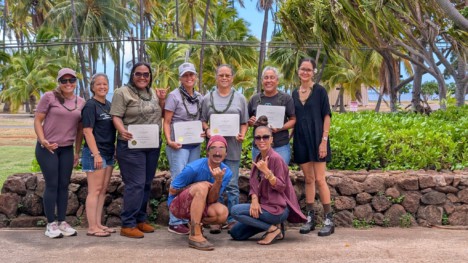Ho‘āhu Program Graduates Six Clean Energy Technicians

Clean Energy Technician graduates and instructors are seen here during their hands-on training and graduation at Kulana ‘Oiwi Aug. 23. Contributed photo
By Léo Azambuja
A literally electrifying program at a Molokai nonprofit organization has produced in the last few years dozens of clean energy technicians ready to put their skills toward cheaper energy and improved quality of life for island residents.
“We are able to now have people who are skilled and knowledgeable in the field of renewable energy. So, as the demand continues on the island, the goal is for the local residents to be able to secure those positions with employers, but also to explore into the entrepreneurship realm,” said Liliana Napoleon, training and workforce developer at Hoʻāhu Energy Cooperative Molokai.
Six residents — Pomaikaʻi Ah Mook Sang, Antonnette Yamamoto, Cheri Rivera, Jonnette Spencer, Kaulunaʻe Hamakua and Brett Waipa — who completed the winter 2024/spring 2025 term of the Clean Energy Technician course through Hoʻāhu attended a hands-on training and graduation at Kulana ʻOiwi Aug. 23.
Since the co-op was formed about five years ago, more than 40 Molokai residents have successfully completed the Clean Energy Technician training in preparation for Hoʻāhu-related renewable energy projects and for the renewable energy workforce demand, whether on island or abroad, according to Napoleon.
The co-op’s mission, she said, is to “create resilient, sustainable, equitable and culturally conscious energy for all on Molokai.”
The Clean Energy Technician certificate is an entry door into a career in the solar industry, Napoleon said. It starts with fundamentals and a solid understanding of various components, system structures and applications for photo-voltaic systems.
Although the course focuses on grid-direct PV systems, it covers material critical to understanding all types of PV systems. The training meets the North American Board of Energy Practitioners’ educational standards for technicians. Completion of this course satisfies NABCEP’s formal classroom training requirement for associate-level testing, she said.
“They get a certificate directly from Makaha Learning Center, which includes the NABCEP (requirements),” Napoleon said.
The course takes about three-to-four months, she said, and it is tailored specifically to meet the busy schedules of the students.
The course’s topics include site analysis, system sizing, array configuration and performance estimation; electrical design characteristics such as wiring, overcurrent protection and grounding; a detailed look at module and inverter specifications and characteristics; mounting methods for various roof structures and ground-mounts; and an introduction to safely and effectively commissioning grid-direct PV systems.
Napoleon said Hoʻāhu is “very fortunate” for being able to work diligently to secure funds to cover 100% of the training’s tuition.
The graduates, she said, now can work as assistants on installation and maintenance of clean energy projects, whether the projects are tied to the electric grid or are off-grid.
“It’s a gateway into the industry,” Napoleon said of their certification.
Most graduates were women in the community, living on Hawaiian homestead land. Many do not have access to the grid, not necessarily by choice, but for the fact that Hawaiian Electric Company has not brought electric lines to their properties, according to Napoleon.
“So, these skill sets are really a part of their survival method as well to transition their families from gasoline generators to off-grid clean energy systems,” she said, adding in these cases, the knowledge from the training also serves a resource for their livelihood.
Napoleon said Ho‘ahu is on the “horizon of expansion” as they start to move into projects such as the Community Based Renewable Energy, other off-grid projects and the continuous accessibility for residents to gain the proper education, training and knowledge to set forth into the field of renewable energy.
“The future for Molokai in terms of renewable energy is definitely bright,” she said.
Currently, two solar farms are being planned — in Pālāʻau and Kualapuʻu — for the CBRE project. The goal, Napoleon said, is to allow residents who may not have the capital to install a solar system on their homes to receive a discount on their electric bill through a co-op membership subscription.
Visit www.hoahuenergy.coop for more information.











Don't have a Molokai Dispatch ID?
Sign up is easy. Sign up now
You must login to post a comment.
Lost Password